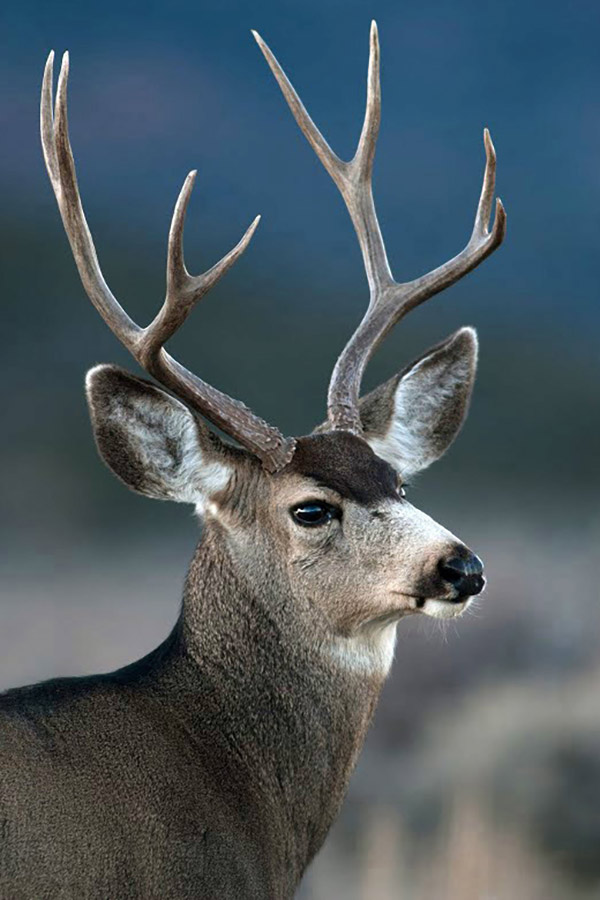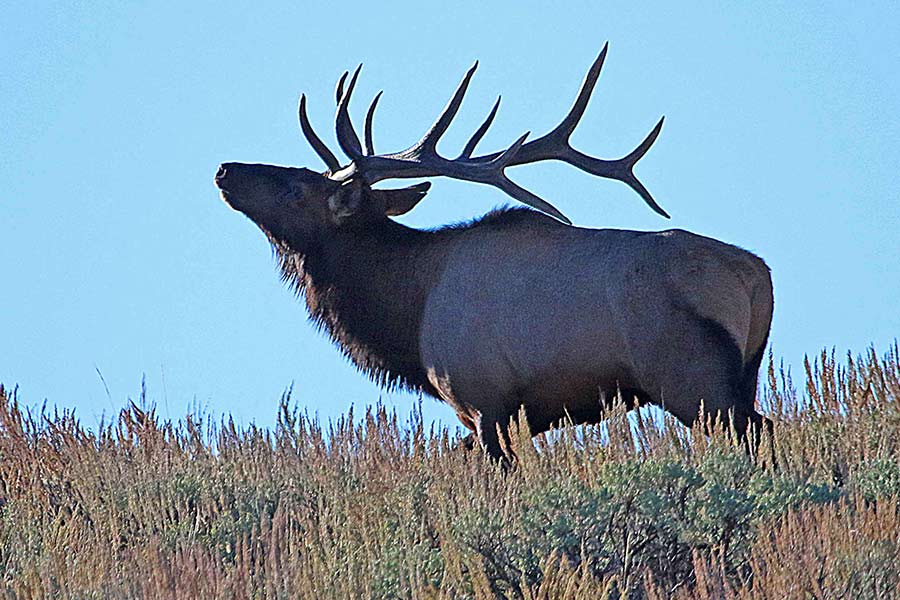What hunters should know for the 2024 Utah deer and elk hunts
Salt Lake City — If you are going to hunt deer or elk in Utah this fall, here is some important information and tips that will be helpful when planning and preparing for your hunt.
Hunt dates
- The general-season buck deer archery hunt and the general spike and any-bull elk archery hunts are the first big game hunts of Utah's fall season, and they all begin Saturday, Aug. 17.
- The early-season hunt for the general-season any-bull elk any-legal weapon hunt will be held Oct. 5–11, and the late-season hunt will be held Oct. 12–18.
- The general-season buck deer hunt (with any legal weapon) runs from Oct. 19–27.
- The general-season muzzleloader elk hunt will be held Oct. 30 to Nov. 7.
For all the general-season hunt dates, see page 7 of the 2024 Utah Big Game Field Regulations guidebook.
Deer hunts
The deer hunting this fall will vary, depending on which areas of the state people are hunting. The deer populations in Cache, Weber, Summit and Morgan counties are still recovering from the severe winter conditions and lower survival rates from the record-breaking winter in 2022–23. As a result, there are fewer deer available for hunters in those areas this fall.
However, other areas of Utah — including southern Utah — had favorable conditions the past three winters, which resulted in above-average deer survival rates and great habitat conditions this spring and summer. Hunters in those parts of the state are likely to encounter good numbers of younger bucks, as well as some older bucks in their hunting units.
"During our big game captures this last winter, we found that a majority of the deer throughout the state were healthy and in great condition with high body fat," Utah Division of Wildlife Resources Big Game Coordinator Dax Mangus said. "Our animals with GPS collars showed high survival rates in both northern and southern Utah. We are happy to see our deer populations continuing to recover after being hit hard by the severe winter in 2022–23, especially in the northern parts of the state. Deer populations in southern Utah are looking good currently, with their third consecutive year of good fawn production and high survival rates."
Elk hunts
The current statewide elk management plan includes an objective to have almost 80,000 elk across Utah. There are currently an estimated 80,600 elk in the state, so elk populations are slightly above objective statewide.
Anyone who wants to hunt elk in Utah this year should note that there are still some archery antlerless elk permits available as well as unlimited over-the-counter late-season any legal weapon any-bull permits.
In addition to these permits, there are many opportunities for youth to hunt elk. Utah offers unlimited general-season youth bull elk permits, which allow youth to hunt all of the general-season archery, general-season any weapon and general-season muzzleloader dates on both general spike-only and any bull units. (Youth hunters must follow spike-only antler regulations on spike units.) People interested in buying these permits can purchase them online, at a DWR office or from any available license agent.
"The ability for hunters to get in the field pursuing big game regularly is a high priority for hunters and the DWR," Mangus said. "This is especially important for our younger hunters, and we are excited about the multiple season dates and extensive unit locations offered to youth hunters with the general-season youth elk permit. We hope parents and families take advantage of the long, flexible season dates to work around busy schedules and get out in the field with their youth hunters to make lasting memories. Spending time in the great outdoors pursuing elk with our youth and our families creates bonds and establishes treasured traditions that last for generations."
General tips
Do your research before heading out, know the laws and scout the area in advance
It is a good idea to visit the Utah Hunt Planner before heading out into the field. This great online resource includes notes from the biologists who manage the various hunting units across the state, as well as general information about the units and safety and weather items. You can see information about the number of bucks on the units, compared to the number of does. You'll also find maps that show the units' boundaries, which land is public and private, and the various types of deer habitat on the unit.
"Hunters who have scouted their hunting units and spent time locating animals before the hunt begins are typically more successful at finding, pursuing and harvesting an animal during their hunt," Mangus said. "Spend time scouting, and if you haven't, consider planning multiple hunting trips during the hunting season. Treat your early hunting dates in the season as hunting and scouting, and try to cover lots of ground to locate animals."
As a reminder, there are a few changes to big game hunting this year. Here are some of the new laws to be aware of:
- Mandatory harvest reporting: Harvest reporting is now required for all of the general-season buck deer and bull elk hunts in Utah, in addition to the limited-entry and antlerless hunts. Permit holders will have 30 days to report the results of their hunt after their hunting season ends. Anyone who doesn't report will be excluded from the following year's big game and antlerless applications.
- Weapons technology changes: Several regulation changes were also approved by the Utah Wildlife Board to Utah's allowed weapons technologies, including prohibiting the use of scopes stronger than 1× power on muzzleloaders for all muzzleloader hunts.
- Night-vision devices: Recent updates were made to the rule regarding night-vision devices to clarify that it is not only unlawful to use, but it's also unlawful to possess night-vision equipment while taking or locating big game from July 31 to Dec. 31. This update was implemented in order to make the rule enforceable for conservation officers.
For information about all the new changes and laws for hunting big game this fall, hunters should check the 2024 Utah Big Game Field Regulations Guidebook.
Practice with your equipment
Whether you are archery hunting or using firearms, it's a good idea to practice regularly with your equipment so you are familiar with it and have the skills needed to hit your target.
"Making responsible and ethical shots is an important part of using our wildlife resources wisely," Mangus said.
Locating animals
Locating animals at a distance with binoculars and spotting scopes can save hunters lots of time and miles. In addition to using optics during prime times for animal movement, hiking to look for fresh tracks and scat can help hunters dial-in to where they want to spend time hunting. Often, an animal's patterns, movements and distribution can change due to hot and dry conditions, precipitation, fires, increased human traffic in an area and other factors. Spending time in the field and being willing to adapt to changing conditions are essential to being successful.
"Hunters who cover more ground and find sources of food, water and/or cover being used by big game are more likely to be successful during their hunt," Mangus said. "Don't be afraid to move and explore within your unit, especially if you are not seeing what you're looking for. Being adaptable and willing to make adjustments can make all the difference."
Hunt away from the road
If you are hoping to harvest a deer or elk this fall, make sure you are hunting in areas away from the road.
"Elk are smart and know how to avoid hunting pressure. They avoid roads, so especially when you are hunting elk, get off the road," Mangus said. "Get out and do some hiking and scouting to find where the animals are."
Look for rugged terrain
When it comes to deer, mature bucks and does are not together during the August archery hunts. So if you are seeing a lot of does in an area, it's a sign that you should probably move to a different spot. Does have to care for their fawns, so they typically prefer areas where there is a lot of water and the terrain is more gentle, like in rolling aspen groves.
"Bucks will gather in small herds or 'bachelor groups,' and they like more rugged mountain terrain," Mangus said. "So, if you are looking for a bigger buck, look for terrain that is harder to access."
Pay attention to the direction of the wind
It's been said that "an elk will hear you three times, they will see you twice, but they will only smell you once!" It's critical that archery hunters know the direction of the wind. That way, you can make adjustments and prevent your scent from reaching the animals before you get within range. As the sun heats the ground, the wind direction changes. For example, wind almost always blows up canyons in the morning and down canyons in the afternoon.
To know the direction the wind is blowing, you can buy an inexpensive item called a wind or breeze checker. Releasing powder from the checker will let you know the direction the wind is blowing. Once you've determined the direction of the wind, approach the deer with that direction (and likely wind shifts) in mind to decrease the chances of your scent blowing the stalk.
Be prepared for the weather and possible emergencies
You should also be prepared for any weather and should always have a first-aid kit and plenty of water. The weather in Utah's mountains can change very quickly and go from sunny to snowing in a matter of minutes, so you need to be prepared with adequate clothing and supplies.
"We urge hunters to remember the safety basics of hunting with a partner and always make sure someone knows where you are and when you will return," Mangus said. "You can't always rely on cell phones as they may not have reception in the backcountry during your hunt."
Use binoculars and be stealthy
Having success during the archery hunt requires stealth and patience. For example, if you're going to use a spot-and-stalk method, don't just walk through the woods, hoping to find a deer without spooking it. Instead, spend time looking through binoculars at an area to find deer and locate where they're bedding. Then, after they've bedded down, plan your stalk, remaining quiet and doing all you can to approach the deer at an angle that keeps your scent from reaching them.
"Stealth and knowing the wind direction are more important for archery hunters than for rifle hunters, as archery hunters need to get closer to the animal to be effective," Mangus said. "It all depends on the hunter and their skill level, and equipment, but typically, most bows have sights that allow for shooting at 60 yards or less. And, typically, the accuracy of most rifles or shooters starts to decline significantly between 300–400 yards. I recommend not trying to 'overshoot' your equipment or experience. Stick with a distance where you have practiced and are comfortable. You should also always know what is beyond your target before taking a shot."
Keep the meat cool
In hot temperatures (especially during the archery hunt), meat from harvested animals can spoil quickly. It's important to get the meat cooled down as soon as possible after harvesting the animal. Removing the hide from the meat and removing the meat from the bone will help. After that, use game bags to keep the meat clean and you can use an iced cooler to lower the temperature of the meat in transport.
"Dry ice can be used to cool the meat quickly and keep it cool for a prolonged period," Mangus said. "You want to keep the meat as cool as possible until you can get it processed and into your freezer."
"Hunting should be fun, and you should enjoy it. It's a great time to see Utah's amazing wildlife and to make memories with your family and friends. Get outdoors this fall and have an adventure or two in our beautiful state."



















